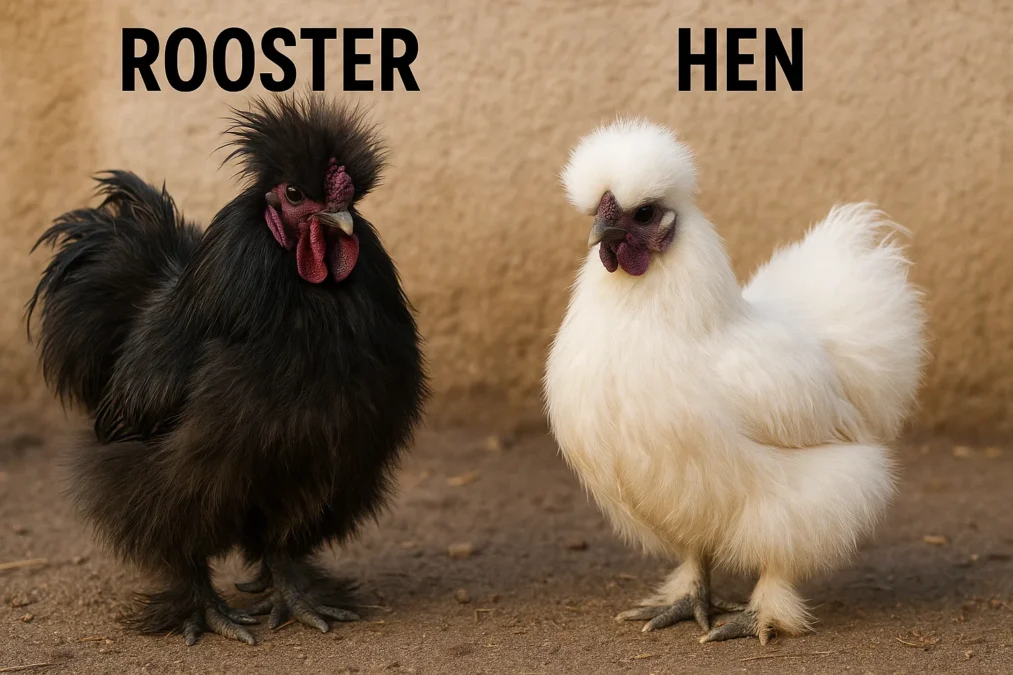So, you’ve fallen in love with the fluffy, pom-pom appearance of Silkie chickens. Their unique looks, gentle demeanor, and reputation as fantastic mothers make them a favorite in backyards worldwide. But now you have a bunch of these adorable puffballs running around, and you’re faced with the age-old poultry puzzle: which ones are boys and which ones are girls? Telling a silkie rooster vs hen apart is famously tricky, especially when they are young. Their extravagant fluffy plumage hides many of the standard clues you’d use with other chicken breeds.
Fear not! Whether you’re planning your flock, hoping for eggs, or just curious about your feathered friends, this comprehensive guide will walk you through every single detail. We’ll dive deep into the physical characteristics, behavioral tells, vocalizations, and even the subtle nuances that separate the gentlemen from the ladies. By the end of this read, you’ll be a certified Silkie gender-detecting expert, ready to confidently answer the question: silkie rooster vs hen?
The Unique Challenge of Silkie Sexing
For most standard chicken breeds, sexing chicks or adults involves looking for clear differences in feather development, comb size, and body structure. Roosters typically have larger, brighter combs and wattles, longer and pointier saddle and hackle feathers, and an overall more assertive posture. Hens are often more subdued in color and possess rounded feathers. But Silkies throw a major wrench into this system.
Their defining feature—that soft, hair-like, profuse fluff—obscures almost all of these visual cues. Their feathers lack the barbicels that hold most feathers together, creating their signature fuzzy look instead of a sleek appearance. This means you won’t see the long, pointed saddle feathers on a silkie rooster like you would on a Leghorn. Their combs and wattles are often a dark mulberry color and can be hidden by crest fluff, making size comparisons difficult. This is why the question of silkie rooster vs hen is such a popular topic among poultry enthusiasts. It requires a more nuanced, multi-faceted approach that combines several observations over time.
Patience is your greatest ally. While some Silkies may show hints early on, for many, you simply cannot be 100% certain until they reach maturity and start exhibiting undeniable behaviors, like crowing or laying an egg. It’s a waiting game that can sometimes take 5-7 months. Embrace the mystery! The surprise is part of the joy of raising these incredible birds. The key is to not rely on just one method but to become a detective, piecing together all the clues we’re about to discuss.
Physical Differences Between a Silkie Rooster and Hen
Although tricky, there are physical attributes you can examine. You need to look past the fluff and focus on specific areas. Remember, these are general guidelines, and there are always exceptions, especially with genetics playing a role.
One of the most reliable physical indicators is the crest. A silkie rooster vs hen often has a more disheveled and rounded crest. It might look like a messy, overflowing pom-pom because the feathers tend to stream backward, sometimes almost looking like a mullet. A hen’s crest, by contrast, is typically very neat, perfectly rounded, and ball-shaped. It sits tidily on top of her head. This difference arises because the rooster’s skull structure is slightly different, allowing for a more prominent and wilder crest.
Another area to scrutinize is the comb and wattles. If you can gently part the fluff on the head and under the beak, you might get a glimpse. Generally, a silkie rooster will have a larger, wider comb and more pronounced, larger wattles than a hen. However, because the Silkie comb is walnut-shaped (a genetic trait), the difference can be subtle. A hen’s comb and wattles will be smaller, neater, and less developed. The color is usually the same dark mulberry in both sexes, so focus on size and prominence rather than color.
Body Shape and Size Over Time
As Silkies mature, their body shape begins to tell a story. A silkie rooster will typically become larger and more substantial than a hen. He will develop a broader, more muscular chest and a taller, more upright stance. His legs will often be slightly longer and thicker, and he may develop larger, more pronounced spurs. However, spur development is not a guaranteed sign, as some hens can develop small spurs, and some roosters can be slow to grow them.
The hen, on the other hand, will usually have a softer, rounder, and wider body profile. This is especially noticeable from a top-down view. She is built for egg production and brooding, so her abdomen and vent area will appear broader and more capacious. When comparing birds of the same age side-by-side, the rooster often looks just a bit more “leggy” and assertive in his posture, while the hen appears more compact and grounded. These differences are minimal in chicks but become more apparent from about 12-16 weeks onward.
Behavioral Clues: How They Act
If the physical clues leave you guessing, behavior will often scream the answer. The personalities of a silkie rooster vs hen can be distinctly different, though individual temperaments always vary.
A silkie rooster, like all roosters, has a job to do. He is the flock’s guardian, lookout, and manager. You will see him practicing for this role as he grows. He will be more alert, often standing tall and scanning the horizon for threats. He might be more bold and curious, investigating new things in the run first. You may see him starting to “tidbit”— making a characteristic clucking sound while picking up and dropping food to show the hens where a tasty morsel is. This is a classic courtship and nurturing behavior. He might also start to assert himself in small ways with other young cockerels, engaging in mini stand-offs or wing flapping.
A silkie hen’s behavior is typically more focused on foraging and socializing within the flock. She is less likely to be the one constantly on high alert. She might be more consistently busy scratching and pecking at the ground. While she can certainly be curious, her demeanor is generally less assertive than the rooster’s. Of course, every flock has its pecking order, and a dominant hen can easily be more assertive than a submissive rooster, so these behaviors must be observed in context and over time.
The Ultimate Giveaway: Crowing and Egg Laying
There are two behaviors that remove all doubt: crowing and laying eggs. You simply cannot argue with them. The first crow is the most definitive sign you have a silkie rooster on your hands. A silkie’s crow is often adorably pathetic at first—a squeaky, broken, and hilarious attempt that slowly matures into a proper, though usually still quieter and more muffled, cock-a-doodle-doo. It might not be the loud, piercing crow of a production breed, but it is unmistakably a crow.
Conversely, the absolute confirmation of a silkie hen is the sight of a egg. Silkies are not known for being prolific layers, often producing only 2-4 small, cream-colored eggs per week. But when she starts laying, usually between 6-9 months of age, the mystery is solved. You might also notice “egg song” behavior before this event—a loud, distinctive squawking she does before, during, or after laying an egg, seemingly proud of her accomplishment. Another pre-laying behavior is a submissive squat: if you go to pet a hen on her back as she matures, she may crouch down flat, wings slightly out. This is a natural mating posture and a strong indicator you have a pullet.
Temperament and Personality Profiles
One of the reasons people love Silkies is their wonderfully gentle nature. This holds true for both sexes, but it manifests in different ways. Understanding the personality differences between a silkie rooster vs hen can help you manage your flock and set expectations.
The silkie rooster is often hailed as one of the most gentle and manageable roosters in the chicken world. He is typically less aggressive and more tolerant than roosters of larger, more assertive breeds. His protective instincts are strong, but they are usually expressed through vigilant watching and alerting his hens to danger rather than through outright aggression. He is often incredibly affectionate with his humans and can become a real lap chicken. He will watch over his ladies with dedication, finding them food and keeping the peace within the flock. Of course, there are exceptions, and some Silkie roosters can become territorial or hormonal, but they are generally known for their sweet dispositions.
The silkie hen is the quintessential motherly figure. She is docile, friendly, and often incredibly broody. In fact, Silkies are famous for their tendency to go broody—a strong desire to sit on eggs and hatch chicks—at the drop of a hat. They will happily sit on any egg, including those from other hens or even other bird species. This makes them fantastic mothers but frustrating layers, as a broody hen will stop laying for months at a time. Hens are often just as friendly as roosters, eager to hop into your lap for a treat or follow you around the garden. They tend to be less vocal overall than roosters, aside from the famous egg song.
Rooster vs Hen: Your Ultimate Guide to Telling Them Apart and Understanding Their Roles
The Sound of Silkies: Vocalizations
Listening to your flock is a key part of the detective work. The vocalizations of a silkie rooster vs hen have distinct patterns and purposes.
The rooster’s vocal repertoire is extensive. It includes the crow, of course, but also a variety of other sounds. He will use low, guttural clucks to alert the hens to food (tidbitting). He has a specific alarm call for aerial predators (often a high-pitched, short squeal) and a different one for ground predators (a lower, repetitive clucking sound). He might also make a sort of grumbling noise to herd his hens or express mild discontent. The crow itself can happen at any time of day, not just dawn, and serves to announce his territory and assert his presence.
The hen’s sounds are primarily focused on communication within the flock. She has a soft, conversational cluck that she uses while foraging. She has her own alarm calls, often taking the rooster’s cue and repeating it. And then, there is the egg song. This is a loud, persistent, and often chaotic series of squawks, clucks, and cries that can last for several minutes. It’s a communal announcement, and other hens will often join in. It’s one of the noisiest things a backyard flock will do, and it’s a clear sign you have hens in residence.
Practical Considerations for Your Flock
Why does identifying a silkie rooster vs hen matter so much? It goes beyond simple curiosity and has real implications for managing your backyard flock.
First, check your local ordinances. Many urban and suburban areas have strict rules against keeping roosters due to their crowing. While a Silkie’s crow is quieter, it is still a crow and can disturb close neighbors. If you are in a restricted area, discovering you have a rooster can mean having to rehome him, which is a heartbreaking decision. Knowing early gives you more time to plan. Second, roosters are essential if you want to hatch fertile eggs. One silkie rooster can easily manage a flock of 5-10 hens. If your goal is breeding, you’ll need to be able to identify a good, quality rooster.
For those primarily interested in egg production, hens are the goal. While Silkie hens are not laying champions, they do provide a steady supply of small eggs. Understanding the hen’s broody tendencies is also crucial. You’ll need to know how to “break” a broody hen if you want her to return to laying, or you’ll need to provide fertilized eggs for her to hatch. The dynamics of your flock will also change with a rooster. He will establish a pecking order and may become protective, which could slightly change how you interact with your birds.
| Feature | Silkie Rooster | Silkie Hen |
|---|---|---|
| Primary Purpose | Flock protection, fertilizing eggs | Laying eggs, brooding, raising chicks |
| Crest | Messier, rounded, often streams backward | Neat, perfectly round, ball-shaped |
| Comb & Wattles | Larger, broader, more prominent (when visible) | Smaller, neater, less prominent |
| Body Shape | Larger, more upright, broader chest, longer legs | Softer, rounder, wider abdomen |
| Spurs | Usually develops larger, pronounced spurs | Rarely has spurs, or they are very small |
| Vocalization | Crowing, alarm calls, tidbitting clucks | Egg song, conversational clucks, alarm calls |
| Key Behavior | Alert, tidbitting, protective, may herd hens | Foraging, nesting, going broody, submissive squat |
| Temperament | Generally gentle, protective, affectionate | Docile, friendly, incredibly broody, nurturing |
| Ideal For | Breeding, flock protection, companionship | Egg production, hatching chicks, companionship |
“A Silkie rooster is like a gentle knight in fluffy armor—ever watchful, rarely aggressive, and completely devoted to his ladies.”
“The Silkie hen is the heart of the brood—a feathered paradox of fierce motherhood and docile companionship, often found either laying an egg, sitting on one, or chirping about it loudly.”
Frequently Asked Questions (FAQ)
How early can you tell a silkie rooster from a hen?
It is notoriously difficult to sex Silkie chicks accurately. Some experienced breeders may make educated guesses based on crest size and shape or down color patterns at hatch, but these methods are far from foolproof and have a high rate of error. The most reliable physical clues, like body shape and comb development, begin to show around 8-12 weeks of age. However, for absolute certainty, you often must wait for behavioral cues like crowing (for a rooster) or egg laying (for a hen), which can take 5-7 months.
Can Silkie hens crow like a rooster?
While it is extremely rare, a Silkie hen can occasionally crow. This usually happens in a flock with no rooster present. A dominant hen may take on some of the rooster’s behaviors, including attempting to crow. It can also be triggered by a hormonal imbalance. However, a hen’s crow is typically weaker, raspier, and less consistent than a rooster’s. If you hear a crow and then later find an egg, you likely have a hormonally unique hen! But 99.9% of the time, crowing is the definitive sign of a silkie rooster.
Are Silkie roosters good with children?
Yes, Silkie roosters are generally renowned for their gentle and tolerant nature, making them one of the best rooster breeds for families with children. Their calm disposition means they are less likely to show aggression or spook easily. However, it is crucial to always supervise young children with any animal and teach them how to handle the birds gently and respectfully. Even a gentle rooster may react if he feels threatened or if his hens are being bothered.
How many hens should I have per Silkie rooster?
A good rule of thumb is to have at least 4-6 hens for one Silkie rooster. This ratio helps to prevent over-mating, which can stress the hens and cause feather loss or injury on their backs. A single rooster can manage up to 10-12 hens comfortably. If you have multiple roosters, you will need a larger flock and more space to prevent fighting and ensure the hens’ well-being.
Do Silkie roosters have spurs?
Yes, Silkie roosters do develop spurs, just like other rooster breeds. However, the development can be slow and variable. Some may have prominent, sharp spurs by a year old, while others may have small, rounded nubs. The spur is a bony core covered in a keratin sheath located on the back of the leg. While Silkie roosters are less likely to use them aggressively, it’s still important to monitor spur length for the safety of your hens and yourself, and trim them if necessary.
Conclusion
Deciphering the puzzle of the silkie rooster vs hen is a journey that requires patience, observation, and a keen eye for detail. While their magnificent fluff makes it a challenge, the clues are there—in the wildness of a crest, the subtle size of a comb, the proud stance of a protector, and the busy chatter of a matriarch. From the hilarious first crow to the triumphant egg song, your Silkies will eventually reveal their secrets. Whether you end up with a gentle, watchful rooster or a broody, affectionate hen, you are guaranteed a delightful and charming addition to your backyard flock. Embrace the process of getting to know your unique birds, and enjoy every moment with these incredible, fluffy companions.



